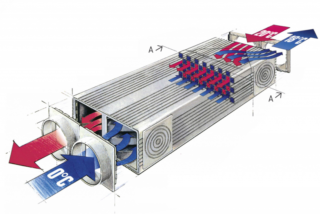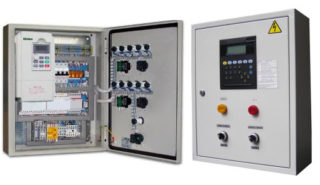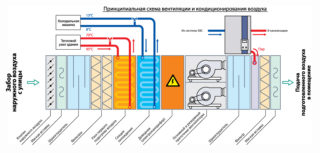Automation of ventilation systems is used to optimize the operation of this type of equipment in a house or industrial premises, to provide smoke protection, and to prevent fires. To improve your targets, you need to choose the right setting.
Determination of functional indicators of ventilation systems

If the automation of ventilation systems is planned in the room, when choosing an installation, one should focus on achieving the values appropriate for this type of room. The standards provide for periodic checks of the quality of ventilation. If it was found that the values of the indicators are less than they should be in theory, the installation is supposed to be improved (for example, automated) or to be repaired.
Traditionally, parameters characterizing the quality of ventilation include:
- the volume of inflow or outflow of air masses per hour;
- the ratio of the areas of the sash through which ventilation is carried out and the floor of the room;
- the frequency of air replacement for each hour.
These criteria are used in hospital and other medical facilities, laboratories, catering establishments and other places where it is important to take extra care of sanitation.
In industrial buildings, measurements of the content of carbon dioxide in the air and the study of its composition by means of gas and aerosol analysis are more often used.
Technical means

The devices by means of which the automation of ventilation of general exchange and other types, as well as air conditioning, is realized, are very diverse. The circuit may include different types of sensors (temperatures of incoming and outgoing flows, pressure, humidity, carbon dioxide content), regulation blocks, actuators, devices that control electric drives. The performance indicators of these devices, the monitoring of which is important for the effective functioning of the installation, are displayed on the control panels and dispatching consoles.
It is possible to automatically control the data when moving away from the specified frames, or to manage them in the submenus. The signals from the sensors are sent to the control cabinet, where they are subjected to analytical processing with the selection of a suitable algorithm for the air conditioning unit.
Advantages and disadvantages

Automation of supply and exhaust ventilation allows you to optimize the operation of the unit, monitor compliance with the target indicators. At the same time, human participation in the management of processes is minimized, which allows workers in a production or institution to devote more time to other tasks. At the same time, when planning the connection of ventilation automation, it is important to correctly calculate, make an estimate and select devices compatible with each other that will provide the proper level of air supply with a minimum of irrational costs. The disadvantages include the possibility of damage to complex electronics.
The automated operation of the ventilation system saves resources due to several factors. This includes fine adjustment of the modes of technology, subordination of work to the schedule. In addition, the functioning of the heat exchanger is maintained in winter (which prevents it from freezing) in parallel with minimizing heat consumption. This allows you to optimize work in the cold season.
The main sections of the automation of ventilation systems
In the operation and automation of ventilation systems, the correct selection of plant components is of great importance. It is determined by the purpose of the designed configuration.
Automation system for modular ventilation systems

Modular units are assembled from separate components: noise mufflers, air ducts, air heaters, etc. They are distinguished by their simplicity and reliability. The ventilation control unit must maintain the set temperature inside the room, protect the air heater from freezing, and control the speed of rotation of the fan. It consists of the following components:
- Sensors that measure various indicators: temperature, humidity, etc. They are selected depending on the conditions of use of the installation and how accurate the measurements should be.
- Control devices that control actuators based on sensor data.
- Control devices.
- Data entry equipment.
- Executive mechanisms.
The electronic control unit and some of the executive components are often combined inside the automation panel.
Fire ventilation automation system
This includes various installations for protection against fires, which are equipped with premises and buildings with a high fire hazard. They include signaling devices, equipment for automatic extinguishing, smoke protection, evacuation assistance. The fire-fighting equipment of buildings also includes a special internal water supply and elevator sections for the relevant specialists. Equipment of this kind should inform the people inside the premises about the fire, limit the spread of combustion, and help in the implementation of evacuation measures. The installation can be blocked for additional doses of a fire extinguisher, creating obstacles in the path of fire.
Central air conditioning automation system

The equipment controlled by such systems is designed to control the climate in various industrial or commercial premises. This includes different types of refrigeration and air conditioning equipment. Automatic control units are usually built into the equipment itself or supplied by the manufacturer in conjunction with it. The design and production of automation for a specific installation according to the terms of reference prepared by the customer is widespread.
Automatic ventilation control helps maintain target parameters within specified limits, minimizing operator intervention. The main components of the systems are different types of sensors and electronic control units located in the automation panels.








